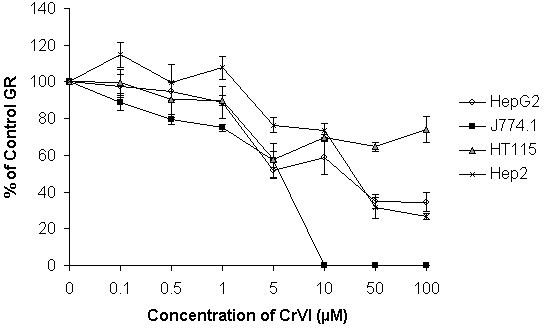| pA2 online © Copyright 2004 The British Pharmacological Society |
139P
University of Newcastle Winter Meeting December 2004 |
Inhibition of glutathione reductase by Shahnaz Bibi, Flora Angeli and M Helen Grant, Bioengineering Unit, University of Strathclyde, Glasgow G4 0NW. |
|
Chromium (VI) compounds have serious toxic and carcinogenic effects in humans. To exert toxicity and carcinogenicity Cr (VI) must be reduced inside cells, and it can be reduced both enzymatically and non-enyzmatically. Glutathione reductase (GR) has been implicated in the intracellular reduction of Cr (VI). This enzyme normally re-cycles reduced glutathione (GSH) from oxidized glutathione (GSSG), and is essential for protecting cells against intermediates which deplete GSH, and against oxidative stress. During its reduction inside cells Cr (VI) disrupts redox balance, and generates reactive oxygen species. These oxidize GSH and deplete reduced thiols, leading to toxicity and carcinogenesis. Susceptibility to Cr (VI) will depend on the ability of cells to protect themselves by recycling GSH via GR. The effect of exposure to Cr (VI) in vitro on the activity of GR in cells derived from liver (Hep G2 cells), colon (HT 115 cells), larynx (Hep 2 cells) and macrophages (J774.1 cells) was investigated.
Cells were exposed to Cr (VI) concentrations from 0.1 to 100 µM for 48 hours and thereafter GR activity and GSH content measured. Figure 1 shows that during exposure to Cr (VI) GR is inhibited, but to different extents in each cell type. Macrophages are particularly sensitive to GR inhibition, the activity being undetectable after exposure to 10 µM Cr (VI). Depletion of GSH content by Cr (VI) was greatest in cells demonstrating the greatest inhibition of GR. At 100 µM Cr (VI), GSH was 55.38+/- 0.28% of control levels in HT115 cells; 23.84 +/- 0.84% in Hep G2 cells; 6.48 +/- 0.25% in Hep 2 cells and undetectable in J774.1 cells.

Figure 1: Inhibition of GR by Cr(VI). Controls in the absence of Cr(VI) are expressed as 100%. Mean ± sem (n=3). * p<0.05, by ANOVA followed by Dunnett’s test compared with controls from the same cell type.
Inhibition of GR activity in macrophages may provide a useful marker for exposure to Cr (VI) in vivo. The sensitivity of macrophages to Cr (VI) toxicity will reduce immuno-surveillance in vivo and may contribute to mechanisms of Cr (VI) induced carcinogenesis.